| dc.description.abstract | There are several challenges when it comes to analyze the pressure situation in service lines, such as roughness and inner diameter of pipes, water flow rate through pipe and the pressure loss at tapping sleeves.
Roughness and inner diameter of some pipes will change over time as a result of processes between the inner side of pipe walls and water flowing through pipes. Water demand for garden irrigation and expected maximum demand are the critical demands which hydraulic system is required to provide for residents. Another challenge is to analyze the pressure loss at tapping sleeves.
The goal for this thesis is to analyze the effect of these parameters on pressure loss. In this thesis consists of two main parts: theoretical part, and simulation of the hydraulic model and analyzing the results.
Reduction of inner diameter in aged iron-based pipes, such as galvanized steel or cast-iron pipe is complicated. This thesis assumed that 50 % reduction of diameter in galvanized pipes and cast-iron pipes in 50 years, could be a proper estimation. Reduction in diameter for other types of material is neglectable.
Although the effect of local pressure loss on total pressure loss was investigated, but it was not possible to clarify how the local pressure loss coefficient is defined in Aquis. Loss coefficient is presented in graphs based on the ratio of cutout diameter and main branch diameter.
By comparing result in different scenario, for iron-based pipes, it was concluded that the effect of diameter changes on pressure loss (both friction loss and local pressure loss) is considerable. For other type of material, flow rate changes are most decisive parameter causing pressure loss.
Reduction of diameter in galvanized steel pipe, which was widely used in service lines, and also in cutout hole of tapping sleeves, are mostly the result of chemical or physical process inside pipes. This thesis made a hypothesis of 50 % diameter reduction in 50 years for galvanized pipe and cast-iron pipes. More reliable estimation requires further studies. Collecting data and statistical sample of old galvanized steel pipe for “probability estimation” could be a starting point. | nb_NO |

